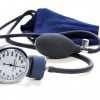 High blood pressure, or hypertension, can cause serious health problems. It makes your heart work harder and can damage your blood vessels even if you feel okay. Everyone should have their blood pressure checked regularly. If you have certain risk factors you are more likely to have high blood pressure. Follow these recommendations to help reduce your risk for high blood pressure. This 6-page fact sheet was written by Linda B. Bobroff, and published by the UF Department of Family Youth and Community Sciences, January 2013.
High blood pressure, or hypertension, can cause serious health problems. It makes your heart work harder and can damage your blood vessels even if you feel okay. Everyone should have their blood pressure checked regularly. If you have certain risk factors you are more likely to have high blood pressure. Follow these recommendations to help reduce your risk for high blood pressure. This 6-page fact sheet was written by Linda B. Bobroff, and published by the UF Department of Family Youth and Community Sciences, January 2013.
http://edis.ifas.ufl.edu/fy305
Category: Families & Consumers
Food Processing: The Meat We Eat (AN283)
 Meat processing technology is used to produce many of the foods we enjoy, such as hot dogs, hamburgers, and chicken nuggets. Recently, the media has focused on certain meat products, giving them names such as “pink slime” and “meat glue.” The names of these products might have many people wondering what we are eating and how the meat we eat is produced. Part of being a good consumer is learning about what you eat, from how the food is made to whether the food is safe. This publication discusses the facts about meat processing so you can make knowledgeable decisions about the meat you eat. This 5-page fact sheet was written by Erica L. Bub, Keith Schneider, Chad Carr, and Matt Hersom, and published by the UF Department of Animal Sciences, December 2012.
Meat processing technology is used to produce many of the foods we enjoy, such as hot dogs, hamburgers, and chicken nuggets. Recently, the media has focused on certain meat products, giving them names such as “pink slime” and “meat glue.” The names of these products might have many people wondering what we are eating and how the meat we eat is produced. Part of being a good consumer is learning about what you eat, from how the food is made to whether the food is safe. This publication discusses the facts about meat processing so you can make knowledgeable decisions about the meat you eat. This 5-page fact sheet was written by Erica L. Bub, Keith Schneider, Chad Carr, and Matt Hersom, and published by the UF Department of Animal Sciences, December 2012.
http://edis.ifas.ufl.edu/an283
Healthy Living: Tips for Staying Regular (FCS8565/FY072)
 Constipation means having a bowel movement fewer than three times a week. Stools are usually hard and can be painful to pass. Constipation is common among older adults.This 1-page fact sheet was written by Linda B. Bobroff, and published by the UF Department of Family Youth and Community Sciences, January 2013.
Constipation means having a bowel movement fewer than three times a week. Stools are usually hard and can be painful to pass. Constipation is common among older adults.This 1-page fact sheet was written by Linda B. Bobroff, and published by the UF Department of Family Youth and Community Sciences, January 2013.
http://edis.ifas.ufl.edu/fy072
Mange in Companion Animals (ENY289/IN953)
 Mange is a persistent skin condition of mammals caused by infestation with parasitic mites. Mites are tiny arthropods, usually less than 1 mm in length and difficult to see with the naked eye. Adult mites have eight legs, and larvae have six. The effect of the mites on the animal’s skin, called “mange,” is the most visible sign of an infestation. This 6-page fact sheet describes several skin conditions commonly caused by parasitic mites in domestic animals. Written by E. N. I. Weeks and P. E. Kaufman, and published by the UF Department of Entomology and Nematology, September 2012.
Mange is a persistent skin condition of mammals caused by infestation with parasitic mites. Mites are tiny arthropods, usually less than 1 mm in length and difficult to see with the naked eye. Adult mites have eight legs, and larvae have six. The effect of the mites on the animal’s skin, called “mange,” is the most visible sign of an infestation. This 6-page fact sheet describes several skin conditions commonly caused by parasitic mites in domestic animals. Written by E. N. I. Weeks and P. E. Kaufman, and published by the UF Department of Entomology and Nematology, September 2012.
http://edis.ifas.ufl.edu/in953
Alimentos funcionales (FSHN1217S/FS213)
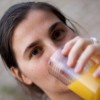 Un alimento funcional es definido comúnmente como un alimento que proveen beneficios más allá de la nutrición básica proporcionada por dicho alimento. El beneficio adicional se debe a un componente en el alimento que ofrece beneficios físicos o biológicos, como por ejemplo, beneficios funcionales. This 4-page fact sheet was written by Amanda Ford y Wendy J. Dahl, and published by the UF Department of Food Science and Human Nutrition, November 2012.
Un alimento funcional es definido comúnmente como un alimento que proveen beneficios más allá de la nutrición básica proporcionada por dicho alimento. El beneficio adicional se debe a un componente en el alimento que ofrece beneficios físicos o biológicos, como por ejemplo, beneficios funcionales. This 4-page fact sheet was written by Amanda Ford y Wendy J. Dahl, and published by the UF Department of Food Science and Human Nutrition, November 2012.
http://edis.ifas.ufl.edu/fs213
Functional Foods (FSHN1217/FS210)
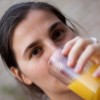 A functional food is commonly defined as a food that provides benefits beyond the basic nutrition provided by that food. The additional benefit is due to a component in the food item that offers physical or biological benefits. As functional foods become increasingly popular in the U.S., it is important to be an informed shopper. This 3-page fact sheet was written by Amanda L. Ford and Wendy J. Dahl, and published by the UF Department of Food Science and Human Nutrition, November 2012.
A functional food is commonly defined as a food that provides benefits beyond the basic nutrition provided by that food. The additional benefit is due to a component in the food item that offers physical or biological benefits. As functional foods become increasingly popular in the U.S., it is important to be an informed shopper. This 3-page fact sheet was written by Amanda L. Ford and Wendy J. Dahl, and published by the UF Department of Food Science and Human Nutrition, November 2012.
http://edis.ifas.ufl.edu/fs210
Food Safety within the Household (FSHN12-10/FS195)
 Although food safety education is well established, people still become infected with foodborne illnesses by practicing unsafe behaviors in their kitchen. People who know the basics of home food safety may not always put theory into practice. Consumers must learn more about how food becomes unsafe to eat and modify their current beliefs and behaviors. This 5-page fact sheet was written by Lucianna Grasso, George L. Baker, Renée M. Goodrich-Schneider, and Keith R. Schneider, and published by the UF Department of Food Science and Human Nutrition, October 2012.
Although food safety education is well established, people still become infected with foodborne illnesses by practicing unsafe behaviors in their kitchen. People who know the basics of home food safety may not always put theory into practice. Consumers must learn more about how food becomes unsafe to eat and modify their current beliefs and behaviors. This 5-page fact sheet was written by Lucianna Grasso, George L. Baker, Renée M. Goodrich-Schneider, and Keith R. Schneider, and published by the UF Department of Food Science and Human Nutrition, October 2012.
http://edis.ifas.ufl.edu/fs195
Spoon Test for Pureed Food (FSHN1211/FS204)
 Puréed foods prepared for people with swallowing problems should meet the recommended textural guidelines. Proper texture is the priority when creating purées. A puréed food should have a uniform texture that is “spoon thick” and does not require chewing. It should not be too dry, sticky, lumpy, or thin. Adjustments in thickness may be made according to the individual’s specific needs. This 2-page fact sheet was written by Wendy J. Dahl and Jamila R. Frazier, and published by the UF Department of Food Science and Human Nutrition, November 2012.
Puréed foods prepared for people with swallowing problems should meet the recommended textural guidelines. Proper texture is the priority when creating purées. A puréed food should have a uniform texture that is “spoon thick” and does not require chewing. It should not be too dry, sticky, lumpy, or thin. Adjustments in thickness may be made according to the individual’s specific needs. This 2-page fact sheet was written by Wendy J. Dahl and Jamila R. Frazier, and published by the UF Department of Food Science and Human Nutrition, November 2012.
http://edis.ifas.ufl.edu/fs204
Salmonella y Escherichia coli enteropatogena en el ambiente de produccion de cultivos: fuentes potenciales, supervivencia y gestion (SL375Span/SS577)
 El objetivo de esta publicación EDIS es poner en evidencia los descubrimientos recientes que se enfocan en la ecología de los patógenos humanos en el área de producción de cultivo. Una mejor comprensión de cómo los patógenos persisten fuera de los huéspedes animales en el agua para la agricultura, en el suelo y en las plantas, tendrá grandes impactos en el manejo y procesamiento de los productos mismos, empezando desde el productor y hasta el consumidor. This 3-page fact sheet was written by Massimiliano Marvasi, Max Teplitski, Andrée George, and George Hochmuth, and published by the UF Department of Soil and Water Science, November 2012.
El objetivo de esta publicación EDIS es poner en evidencia los descubrimientos recientes que se enfocan en la ecología de los patógenos humanos en el área de producción de cultivo. Una mejor comprensión de cómo los patógenos persisten fuera de los huéspedes animales en el agua para la agricultura, en el suelo y en las plantas, tendrá grandes impactos en el manejo y procesamiento de los productos mismos, empezando desde el productor y hasta el consumidor. This 3-page fact sheet was written by Massimiliano Marvasi, Max Teplitski, Andrée George, and George Hochmuth, and published by the UF Department of Soil and Water Science, November 2012.
http://edis.ifas.ufl.edu/ss577
Designing Educational Programs for Older Adults (FCS2216/FY631)
 This 4-page fact sheet discusses marketing to older adults, location and timing of programs, and how to successfully share information with older adults. Written by Martie Gillen, Carolyn Wilken, and Jenny Jump, and published by the UF Department of Family Youth and Community Sciences, November 2012.
This 4-page fact sheet discusses marketing to older adults, location and timing of programs, and how to successfully share information with older adults. Written by Martie Gillen, Carolyn Wilken, and Jenny Jump, and published by the UF Department of Family Youth and Community Sciences, November 2012.
http://edis.ifas.ufl.edu/fy631
Adapting the Home (FCS2215/FY630)
 This 4-page fact sheet discusses AARP’s 10 basic ideas to increase home safety, how to individualize for each person or activity, how to apply universal design to make homes safer, and assistive devices. Written by Martie Gillen, Pat J. Dasler, and Jenny Jump, and published by the UF Department of Family Youth and Community Sciences, November 2012.
This 4-page fact sheet discusses AARP’s 10 basic ideas to increase home safety, how to individualize for each person or activity, how to apply universal design to make homes safer, and assistive devices. Written by Martie Gillen, Pat J. Dasler, and Jenny Jump, and published by the UF Department of Family Youth and Community Sciences, November 2012.
http://edis.ifas.ufl.edu/fy630
Fall Prevention (FCS2214/FY629)
 Among older adults (those 65 or older), falls are the leading cause of injury and death. When someone falls, they face long-term disability, lower productivity, and loss of independence. Falls can happen anywhere, but more than half of all falls happen at home. Many of these falls could be prevented by making simple changes in the home. This 3-page fact sheet was written by Martie Gillen, Kristen D. Smith, and Jenny Jump, and published by the UF Department of Family Youth and Community Sciences, November 2012.
Among older adults (those 65 or older), falls are the leading cause of injury and death. When someone falls, they face long-term disability, lower productivity, and loss of independence. Falls can happen anywhere, but more than half of all falls happen at home. Many of these falls could be prevented by making simple changes in the home. This 3-page fact sheet was written by Martie Gillen, Kristen D. Smith, and Jenny Jump, and published by the UF Department of Family Youth and Community Sciences, November 2012.
http://edis.ifas.ufl.edu/fy629
Financial Issues (FCS2212/FY627)
 Although we cannot foresee unexpected events, planning can help us control some financial issues that may arise. This 4-page fact sheet highlights the main financial poblems older adults face during retirements, and solutions to help plan and manage a successful retirement. Written by Martie Gillen and Josephine Turner, and published by the UF Department of Family Youth and Community Sciences, November 2012.
Although we cannot foresee unexpected events, planning can help us control some financial issues that may arise. This 4-page fact sheet highlights the main financial poblems older adults face during retirements, and solutions to help plan and manage a successful retirement. Written by Martie Gillen and Josephine Turner, and published by the UF Department of Family Youth and Community Sciences, November 2012.
http://edis.ifas.ufl.edu/fy627
Safe Return (FCS2211/FY626)
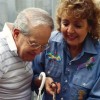 In the United States, more than 10,000 times each year a person with dementia becomes lost in the community and cannot find the way home. The quality of care people receive does not influence the likelihood of people with dementia to become lost. Even people who live in the best caregiving situations can become lost in the community. It can happen to anyone, even if the person does not have a tendency to wander. This 4-page fact sheet looks at why people with dementia become lost, how to prevent this from happening, and identify the best search strategies for finding someone who is lost. Written by Martie Gillen and Meredeth A. Rowe, and published by the UF Department of Family Youth and Community Sciences, November 2012.
In the United States, more than 10,000 times each year a person with dementia becomes lost in the community and cannot find the way home. The quality of care people receive does not influence the likelihood of people with dementia to become lost. Even people who live in the best caregiving situations can become lost in the community. It can happen to anyone, even if the person does not have a tendency to wander. This 4-page fact sheet looks at why people with dementia become lost, how to prevent this from happening, and identify the best search strategies for finding someone who is lost. Written by Martie Gillen and Meredeth A. Rowe, and published by the UF Department of Family Youth and Community Sciences, November 2012.
http://edis.ifas.ufl.edu/fy626
Family Relationships in an Aging Society (FCS2210/FY625)
 Never in the history of America or the world has the population had more older adults than children. This 5-page fact sheet discusses some issues that happen as a result of having a greater number of older adults than children. It also looks at the roles of the family and intergenerational relationships supporting our aging society. Written by Martie Gillen, Terry Mills, and Jenny Jump, and published by the UF Department of Family Youth and Community Sciences, November 2012.
Never in the history of America or the world has the population had more older adults than children. This 5-page fact sheet discusses some issues that happen as a result of having a greater number of older adults than children. It also looks at the roles of the family and intergenerational relationships supporting our aging society. Written by Martie Gillen, Terry Mills, and Jenny Jump, and published by the UF Department of Family Youth and Community Sciences, November 2012.
http://edis.ifas.ufl.edu/fy625
The Food Groups of MyPlate (FCS8873/FY1077)
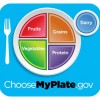 Plan your food group choices wisely. Choose nutrient-rich foods that are fat-free or low-fat and low in added sugars. This 3-page fact sheet gives an overview of the MyPlate food groups. Written by Glenda L. Warren and Jennifer Walsh, and published by the UF Department of Family Youth and Community Sciences, Novemeber 2012.
Plan your food group choices wisely. Choose nutrient-rich foods that are fat-free or low-fat and low in added sugars. This 3-page fact sheet gives an overview of the MyPlate food groups. Written by Glenda L. Warren and Jennifer Walsh, and published by the UF Department of Family Youth and Community Sciences, Novemeber 2012.
http://edis.ifas.ufl.edu/fy1077
Snack Attacks: Be Prepared (FCS8865/FY1020)
 Children may feel hungry or have a “snack attack” right after school each day. Plan ahead and have ready-to-eat healthful foods available for children to enjoy. Use the MyPlate food groups as a guide to prepare snacks that will help children meet their nutritional needs. This 2-page fact sheet was written by Glenda L. Warren and Jennifer Walsh, and published by the UF Department of Family Youth and Community Sciences, November 2012.
Children may feel hungry or have a “snack attack” right after school each day. Plan ahead and have ready-to-eat healthful foods available for children to enjoy. Use the MyPlate food groups as a guide to prepare snacks that will help children meet their nutritional needs. This 2-page fact sheet was written by Glenda L. Warren and Jennifer Walsh, and published by the UF Department of Family Youth and Community Sciences, November 2012.
http://edis.ifas.ufl.edu/fy1020
Saying Goodbye: Military Deployments (FAR0013/FM072)
 “Those last few hugs, the last few kisses, the last few goodbyes are what many military families across the United States have experienced when seeing a loved one leave for deployment. An estimated 1.4 million servicemen and women serve as active duty members in the Army, Navy, Marine Corps, or Air Force. Deployments are nothing new in the military community. However, during these times of separation, family members of those serving, especially the children, undergo many hardships. Studies show children’s reactions to separation can even lead to depression.” This 2-page Family Album Radio transcript was written by Alexandra Ulrich and Suzanna Smith, and published by the UF Department of Family Youth and Community Sciences, November 2012.
“Those last few hugs, the last few kisses, the last few goodbyes are what many military families across the United States have experienced when seeing a loved one leave for deployment. An estimated 1.4 million servicemen and women serve as active duty members in the Army, Navy, Marine Corps, or Air Force. Deployments are nothing new in the military community. However, during these times of separation, family members of those serving, especially the children, undergo many hardships. Studies show children’s reactions to separation can even lead to depression.” This 2-page Family Album Radio transcript was written by Alexandra Ulrich and Suzanna Smith, and published by the UF Department of Family Youth and Community Sciences, November 2012.
http://edis.ifas.ufl.edu/fm072
Ayude a su sistema digestivo: Entendiendo los probioticos (FSHN1111S/FS203)
 Los probióticos son conocidos como “bacterias buenas.” Frecuentemente cuando pensamos en las bacterias, pensamos en las que causan enfermedades. Aunque hay muchas bacterias que causan enfermedades, hay muchas otras que son benéficas para nuestra salud. Los probióticos son microorganismos vivos, los cuales cuando son administrados en cantidades adecuadas, proveen un beneficio para la salud. This 3-page fact sheet was written by Wendy J. Dahl and Volker Mai, and published by the UF Department of Food Science and Human Nutrition, October 2012. http://edis.ifas.ufl.edu/fs203
Los probióticos son conocidos como “bacterias buenas.” Frecuentemente cuando pensamos en las bacterias, pensamos en las que causan enfermedades. Aunque hay muchas bacterias que causan enfermedades, hay muchas otras que son benéficas para nuestra salud. Los probióticos son microorganismos vivos, los cuales cuando son administrados en cantidades adecuadas, proveen un beneficio para la salud. This 3-page fact sheet was written by Wendy J. Dahl and Volker Mai, and published by the UF Department of Food Science and Human Nutrition, October 2012. http://edis.ifas.ufl.edu/fs203
Ayude a su sistema digestivo: Entendiendo la microbiota y los prebioticos (FSHN1110S/FS202)
 Todos nosotros tenemos bacterias buenas por todo nuestro cuerpo. Una población grande de bacterias vive en nuestro tracto gastrointestinal, mayormente en el colon (intestino grueso). Esto se conoce como nuestra flora intestinal. This 2-page fact sheet was written by Wendy J. Dahl and Volker Mai, and published by the UF Department of Food Science and Human Nutrition, October 2012.
Todos nosotros tenemos bacterias buenas por todo nuestro cuerpo. Una población grande de bacterias vive en nuestro tracto gastrointestinal, mayormente en el colon (intestino grueso). Esto se conoce como nuestra flora intestinal. This 2-page fact sheet was written by Wendy J. Dahl and Volker Mai, and published by the UF Department of Food Science and Human Nutrition, October 2012.
http://edis.ifas.ufl.edu/fs202